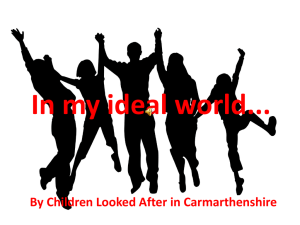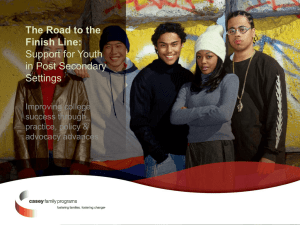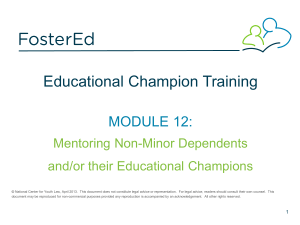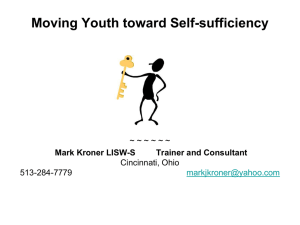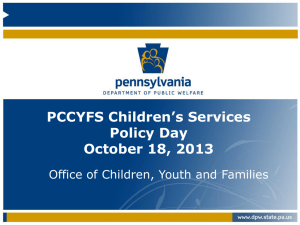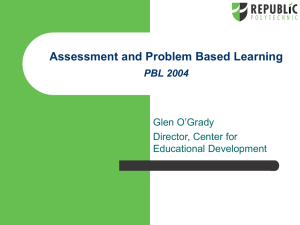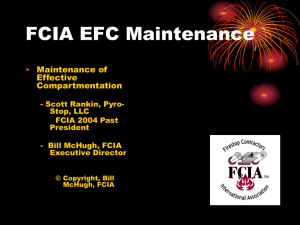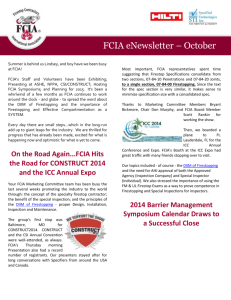a policy analysis of the foster care independence act of 1999
advertisement
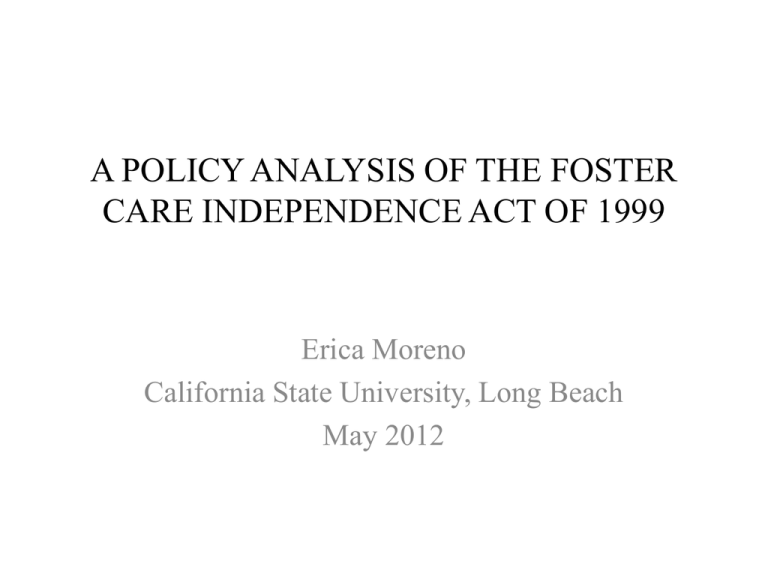
A POLICY ANALYSIS OF THE FOSTER CARE INDEPENDENCE ACT OF 1999 Erica Moreno California State University, Long Beach May 2012 Introduction • Over 20,000 youth nationwide leave the foster care system each year as a result of turning 18 years old and are struggling to make a successful transition into adulthood. • Although states began providing independent living services to older foster youth through previous legislation, those who had already transitioned out were not included. • As former foster youth continued experiencing high rates of homelessness, incarceration, lack of education and unemployment, The Foster Care Independence Act of 1999 (FCIA) was established (FCIA, 1999). • The Foster Care Independence Act of 1999 (FCIA) attempted to address the unmet needs of former foster youth by authorizing funding and extending eligibility for housing, education, employment, counseling and other services to these youth through the age of 21 (FCIA, 1999). Social Work Relevance • The analysis of the FCIA is relevant to social work as there is a high prevalence of this population within the social work field. • Being familiar with the experiences and challenges of this population is important in order to effectively assist this population and advocate for change. • Additionally, it will provide additional insight and knowledge into the effects and implementation of the policy. Literature Review • Several potential outcomes have been identified that former foster youth appear to be at greater risk of facing including: – Homelessness: It has been found that foster youth who have transitioned out of the system experience higher rates of homelessness and often have difficulty securing housing (Dworsky & Courtney, 2009; Reilly, 2003). – Education: It has been found that former foster youth are more likely to drop out of school and less likely to complete postsecondary education (Merdinger, Hines, Osterling, & Wyatt, 2005). – Unemployment: Former foster youth have been found to experience greater difficulty in maintaining employment and are often receiving low wages (Courtney & Dworsky, 2006; Reilly, 2003). – Incarceration: Former foster youth have been found to be at an increased risk of incarceration (Courtney & Dworsky, 2006; Culhane et al., 2011). Methods • This policy analysis used David Gil’s social policy framework from his book Unraveling Social Policy (1992). SECTION A: ISSUES DEALT WITH BY THE POLICY I. Nature, scope, and distribution of the issues. 2. Casual theory(ies) or hypothesis(es) concerning the issues. SECTION B: OBJECTIVES, VALUE PREMISES, THEORETICAL POSITIONS, TARGET SEGMENTS, AND SUBSTANTIATIVE EFFECTS OF THE POLICY I. Policy Objectives: overt objectives and covert objectives. 2. Value premises and ideological orientations underlying the policy objectives: explicit and implicit value premises. 3. Theory(ies) or hypothesis(es) underlying the strategy and the substantive provisions of the policy. 4. Target segments(s) of society- those at whom the policy is aimed: a. Ecological, demographic, biological, psychological, social, economic, political, and cultural characteristics. b. Size of relevant subgroups and of entire target segments projected over time. Methods 5. Short and long-range effects of the policy on target and nontarget segment(s) in ecological, demographic, biological, psychological social, economic, political, and cultural spheres. a. Intended effects and extent of attainment of policy objectives. b. Unintended effects. c. Overall costs and benefits. SECTION C: IMPLICATIONS OF THE POLICY FOR THE OPERATING AND OUTCOME VARIABLES OF SOCIAL POLICIES 1. Changes concerning reproduction, socialization, and social control. 2. Consequences of changes concerning resources, work and production, rights, governance and legitimation, and reproduction, socialization, and social control, for: a. Circumstances of living of individuals, groups, and classes. b. Power of individuals, group, and classes. c. Nature and quality of human relations among individuals, groups, and classes. d. Overall quality of life. (Gil, 1992, p. 71-75) • Primary Sources: Congressional hearings, legislation and policy briefs regarding foster youth. • Secondary Sources: Peer-reviewed journal articles, government reports and books addressing the problem. Results • • Section A: Issues Dealt with by the Policy – Previous law had authorized supportive independent living services for foster youth preparing to transition out of care but had yet to recognize the needs of these youth once they emancipated from care. – Being that the transition process for all youth is often a very slow process, it is no wonder why former foster youth are not prepared at the age of 18 or even 21. Section B: Objectives, Value Premises, Theoretical Positions, Target Segments, and Substantive Effects of the Policy – The main objective of this policy was to improve and expand the Independent Living Program to assist youth in making the transition from the foster care system to selfsufficiency while extending support services to former foster youth up to the age of 21. – One covert objective was the exclusion of the biological family and acknowledging the possibilities of family members being able to be a further support for the youth. – Values of self-sufficiency, personal responsibility, work, and permanency were identified. – One immediate effect was that the federal government provided financial support by increasing the annual funds from $70 million to $140 million (FCIA, 1999). – No longer a minimum age requirement and former foster youth aged 18-21 were now eligible for extended services and health insurance (FCIA,1999). Results • – Implementation of services was an unintended long-term consequence as many eligible youth did not even receive services and continued to experience poor outcomes (GAO, 2007) Section C: Implications of the Policy for the Operating and Outcome Variables of Social Policies – FCIA provided states with the funding and flexibility to create their own independent living programs as long as they fit within the policy objectives (FCIA, 1999). – Even though federal funding was doubled to $140 million each year, the amount provided to each state varied greatly (GAO, 2007). – Given that each state implements the services differently, this provides the states with a great deal of responsibility and minimizes the rights of the actual target population, which is the youth. – The youth were included in the process as their participation was required in deciding which activities would be particularly useful in regards to independent living services (FCIA, 1999). However, the states still make initial decisions on which services are even offered to these youth. Strengths and Challenges of FCIA • Addressing the needs of former foster youth and extending services to age 21 was a major strength of this policy. • The FCIA doubled federal funding from $70 million to $140 million which allowed states more resources to implement services in areas of housing, education, employment, counseling and life skills (FCIA, 1999). • This policy identified the need for permanent support through adoption efforts, mentors and dedicated adults (FCIA, 1999). However, the policy did not include the youth’s biological family as potential support. • There was great flexibility in amount of funding provided to States as well differences in the design and implement of the programs (GAO, 2007). • One major challenge was that many eligible youth were not receiving services and continued to experience poor outcomes after leaving care (GAO, 2007). References Courtney, M.E., & Dworsky, A. (2006). Early outcomes for young adults transitioning from out-of-home care in the USA. Child and Family Social Work, 11, 209-219. Dworsky, A. & Courtney, M.E. (2009). Homelessness and the transition from foster care to adulthood. Child Welfare, 88(4), 23-56. Foster Care Independence Act of 1999, 42 U.S.C. Sec. 1306b (1999). Gil, David G. (1992). Unraveling social policy: theory, analysis, and political action towards social equality (rev. 5th edition). Rochester, VT: Schenkman Books. Merdinger, J.M., Hines, A.M., Osterling, K.L., & Wyatt, P. (2005). Pathways to college for former foster youth: Understanding factors that contribute to educational success. Child Welfare, 84(6), 867-896. Osterling, K.L., D’Andrade, A., & Austin, M.J. (2008). Understanding and addressing racial/ethnic disproportionality in the front end of the child welfare system. Journal of Evidenced-Based Social Work, 5(1/2), 9-30. Reilly, T. (2003). Transitions from care: Status and outcomes of youth who age out of foster care. Child Welfare, 82(6), 727-748. U.S. Government Accountability Office. (2007). Child Welfare: HHS Actions Would Help States Prepare Youth in the Foster Care System for Independent Living. Retrieved from http://www.gao.gov/new.items/d071097t.pdf
